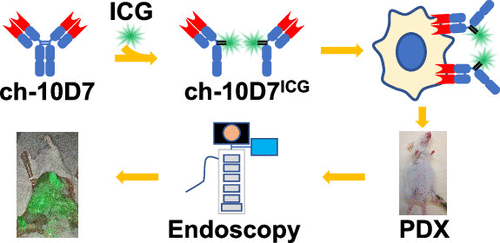当前位置:
X-MOL 学术
›
Mol. Pharmaceutics
›
论文详情
Our official English website, www.x-mol.net, welcomes your
feedback! (Note: you will need to create a separate account there.)
Preclinical Evaluation of a Fluorescent Probe Targeting Receptor CDCP1 for Identification of Ovarian Cancer
Molecular Pharmaceutics ( IF 4.5 ) Pub Date : 2021-08-27 , DOI: 10.1021/acs.molpharmaceut.1c00401 Yaowu He 1 , Tashbib Khan 1 , Thomas Kryza 1 , Martina L Jones 2 , Justin B Goh 2 , Nicholas J Lyons 1 , Lesley A Pearce 3 , Michael D Lee 3 , Madeline Gough 1 , Rebecca Rogers 1, 4 , Claire M Davies 1, 4 , C Blake Gilks 5 , Thomas Hodgkinson 6 , Rohan Lourie 4 , Sinead C Barry 4 , Lewis C Perrin 4 , Charlotte C Williams 3 , Simon Puttick 3 , Timothy E Adams 3 , Trent P Munro 2 , John D Hooper 1 , Naven Chetty 4
Molecular Pharmaceutics ( IF 4.5 ) Pub Date : 2021-08-27 , DOI: 10.1021/acs.molpharmaceut.1c00401 Yaowu He 1 , Tashbib Khan 1 , Thomas Kryza 1 , Martina L Jones 2 , Justin B Goh 2 , Nicholas J Lyons 1 , Lesley A Pearce 3 , Michael D Lee 3 , Madeline Gough 1 , Rebecca Rogers 1, 4 , Claire M Davies 1, 4 , C Blake Gilks 5 , Thomas Hodgkinson 6 , Rohan Lourie 4 , Sinead C Barry 4 , Lewis C Perrin 4 , Charlotte C Williams 3 , Simon Puttick 3 , Timothy E Adams 3 , Trent P Munro 2 , John D Hooper 1 , Naven Chetty 4
Affiliation

|
Optimal cytoreduction for ovarian cancer is often challenging because of aggressive tumor biology and advanced stage. It is a critical issue since the extent of residual disease after surgery is the key predictor of ovarian cancer patient survival. For a limited number of cancers, fluorescence-guided surgery has emerged as an effective aid for tumor delineation and effective cytoreduction. The intravenously administered fluorescent agent, most commonly indocyanine green (ICG), accumulates preferentially in tumors, which are visualized under a fluorescent light source to aid surgery. Insufficient tumor specificity has limited the broad application of these agents in surgical oncology including for ovarian cancer. In this study, we developed a novel tumor-selective fluorescent agent by chemically linking ICG to mouse monoclonal antibody 10D7 that specifically recognizes an ovarian cancer-enriched cell surface receptor, CUB-domain-containing protein 1 (CDCP1). 10D7ICG has high affinity for purified recombinant CDCP1 and CDCP1 that is located on the surface of ovarian cancer cells in vitro and in vivo. Our results show that intravenously administered 10D7ICG accumulates preferentially in ovarian cancer, permitting visualization of xenograft tumors in mice. The data suggest CDCP1 as a rational target for tumor-specific fluorescence-guided surgery for ovarian cancer.
中文翻译:

荧光探针靶向受体 CDCP1 用于卵巢癌鉴定的临床前评价
由于侵袭性肿瘤生物学和晚期,卵巢癌的最佳细胞减灭术通常具有挑战性。这是一个关键问题,因为手术后残留疾病的程度是卵巢癌患者生存的关键预测因素。对于数量有限的癌症,荧光引导手术已成为肿瘤勾画和有效细胞减灭术的有效辅助手段。静脉内给药的荧光剂,最常见的是吲哚菁绿 (ICG),优先积聚在肿瘤中,在荧光光源下可见以帮助手术。肿瘤特异性不足限制了这些药物在外科肿瘤学(包括卵巢癌)中的广泛应用。在这项研究中,我们通过将 ICG 与小鼠单克隆抗体 10D7 化学连接,开发了一种新型肿瘤选择性荧光剂,该抗体特异性识别卵巢癌富集的细胞表面受体,含有 CUB 结构域的蛋白 1 (CDCP1)。10D7ICG对纯化的重组CDCP1和位于体外和体内卵巢癌细胞表面的CDCP1具有高亲和力。我们的研究结果表明,静脉内施用的 10D7 ICG优先在卵巢癌中积累,从而可以观察小鼠的异种移植肿瘤。数据表明CDCP1是肿瘤特异性荧光引导卵巢癌手术的合理靶点。
更新日期:2021-09-06
中文翻译:

荧光探针靶向受体 CDCP1 用于卵巢癌鉴定的临床前评价
由于侵袭性肿瘤生物学和晚期,卵巢癌的最佳细胞减灭术通常具有挑战性。这是一个关键问题,因为手术后残留疾病的程度是卵巢癌患者生存的关键预测因素。对于数量有限的癌症,荧光引导手术已成为肿瘤勾画和有效细胞减灭术的有效辅助手段。静脉内给药的荧光剂,最常见的是吲哚菁绿 (ICG),优先积聚在肿瘤中,在荧光光源下可见以帮助手术。肿瘤特异性不足限制了这些药物在外科肿瘤学(包括卵巢癌)中的广泛应用。在这项研究中,我们通过将 ICG 与小鼠单克隆抗体 10D7 化学连接,开发了一种新型肿瘤选择性荧光剂,该抗体特异性识别卵巢癌富集的细胞表面受体,含有 CUB 结构域的蛋白 1 (CDCP1)。10D7ICG对纯化的重组CDCP1和位于体外和体内卵巢癌细胞表面的CDCP1具有高亲和力。我们的研究结果表明,静脉内施用的 10D7 ICG优先在卵巢癌中积累,从而可以观察小鼠的异种移植肿瘤。数据表明CDCP1是肿瘤特异性荧光引导卵巢癌手术的合理靶点。











































 京公网安备 11010802027423号
京公网安备 11010802027423号